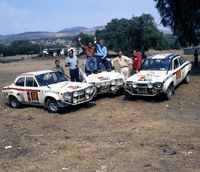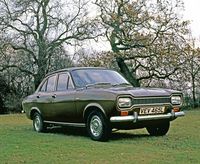High Performing Fords at the Goodwood Festival Of Speed
BRENTWOOD, June 24, 2008: Ford Motor Company, a major sponsor of the Goodwood Festival of Speed since its inception in 1993, will again be supporting this prestigious event to be held over the weekend of 11-13 July 2008.
The Festival of Speed is Europe's premier historic motor sporting event – a combination of hillclimb, rally stage, garden party, and motor show, all in the grounds of Goodwood House, the Earl of March's ancestral home in West Sussex.
Leading the array of famous Ford vehicles on the hillclimb and the forest rally stage will be the Ford Focus RS WRC, which recently claimed a record-breaking 100th consecutive points finishes in the FIA World Rally Championship. With a first and second-place finish on the recent Rally of Turkey, Ford became the first manufacturer since the launch of the WRC in 1973 to reach a century of successive scores.
A stunning array of Ford vehicles
In a year in which Ford
celebrates two important dates – the centenary of the launch of the
Model T and the 40th anniversary of the arrival of the Escort – there
will be an array of famous Ford vehicles at Goodwood. Ford will be
represented on the Hillclimb, on the Forest Rally Stage, and also in the
Cartier Style et Luxe Concours. In addition, many of the famous racing F1
and racing sports cars present will be powered by Cosworth-Ford V8 or V10
engines.
There were successful Model Ts in motor racing in the 1920s, Ford V8s won the Monte Carlo rally in the 1930s, and since the 1950s Ford has always been prominent in racing and rallying, often with specially-developed cars such as the Escort RS1600 and RS1800, the RS200, the Sierra RS500 Cosworth, and racing Mondeos. Ford-powered cars from all around the world will be present, ranging from Indy 500 winners, to successful British Touring Car Championship machines, an ex-Michael Schumacher Benetton-Ford F1 car and Escort Mk IIs which dominated world rallying for so long.
Current WRC Champions
Ford success at world level continues to
this day, and the record-breaking Focus RS WRC features on the Hillclimb
and the Forest Rally Stage driven by current drivers' championship leader
Mikko Hirvonen. Ford is also leading the manufacturers' standings in
pursuit of a third consecutive FIA World Rally Championship after winning
the manufacturers' title in 2006 and 2007.
Joining the Focus WRC cars on the Forest Rally Stage will be a Ford Escort RS1800 rally car driven by 1979 rally world champion, Björn Waldegård.
Visitors to the Goodwood Festival of Speed will see an astonishing variety of other famous Fords, ranging from the Le Mans-winning GT40, RS200, NASCAR Taurus, the 7-litre Galaxie which changed the face of British saloon car racing in 1963, and an ex-Jim Clark racing Lotus Cortina.
Escort and Model T celebrations
Immediately after its public
launch in 1968, the Escort became a race and rally winner and went on to
record many victories. Escorts won the European and British Touring Car
Championships in the 1970s, and were twice World Rally Champions, in 1979
and 1981. Escorts won the Monte Carlo rally, the East African Safari and
the London-Mexico World Cup rally, and they triumphed on the British RAC
rally on eight consecutive occasions (1972 – 1979).
Although the Model T was not designed as a competition car, it became successful in everything from long distance trials, to specialised formula racing in the US. As the world’s best selling car of the 1910s and 1920s, Model Ts found fame in many ways. A selection of special types will be on show in the Style et Luxe Concours. Model Ts, it seems, not only provided trouble-free motoring and bargain prices for millions, but could also be used in show business, as commercial vehicles, and in the most inhospitable terrain.
40 years of Ford Escort
In January 1968, Ford launched the all-new Escort family saloon, which became an all-time best-seller. In a 32-year career the Escort always offered remarkable value for money and, to keep abreast of trends and customer demands, the style, specification and equipment of the Escort was regularly refreshed.
The original Escort coupled a simple but attractive style with innovations, including a new all-synchromesh transmission, rack-and-pinion steering for the first time on any Ford, front-wheel disc brakes on some models, and a novel body shell construction which incorporated massive one-piece body side pressings.
By the standards of the day, the first Escort offered remarkable performance from a 50bhp/1,098cc engine, with a top speed of 80mph, typical fuel consumption of 35mpg and all for no more than £605.
UK market leadership
Ford became UK market leaders during the
Escort’s career, and has kept that lead ever since. Initial Escort
production was concentrated at the Halewood plant, on Merseyside.
Production at Saarlouis in Germany followed within a year, and many other
Escorts were later assembled at other Ford plants around the world.
Larger and more powerful engines, optional automatic transmission, four-door, estate car and light commercial vehicle types were added to the original two-door saloon, along with many different trim packs and options. The famous Twin-Cam and the equally legendary RS1600 helped to make the Escort the world’s most successful competition saloon car.
A newly-styled Escort appeared in 1975 to keep the range at the head of the sales charts for five years. In 1980 an entirely new Escort took over. Not only did this, the Mk III, have a smart hatchback style, but it also featured a transversely-mounted overhead-camshaft engine and front-wheel-drive.
A much up-dated range of cars (the Mk IV) followed in 1986 with the Escort's final major change happening in 1990. In 1998 Ford introduced an all-new replacement to its fastest-selling family car, the Focus.
Motorsport triumphs
Specialised Escorts were spectacular and
triumphant race and rally cars at competitions all around the world,
winning more events than any of their rivals. Victory in prestigious
rallies such as the Monte Carlo, East African Safari, British RAC and World
Cup rallies were matched by success in European and British Touring Car
race series, these being delivered by heroes like Roger Clark, Hannu
Mikkola and Ari Vatanen.
When the Escort came to the end of its glittering career, an outstanding car was needed to take over. The Focus was a worthy successor to the Escort, and has itself always been a great success in both the sales charts and in motorsport.
Ford’s best-selling model, the Model T, is 100 years old
The Model T, affectionately known as the "Tin Lizzie", was launched in October 1908, and rapidly became the world’s best-selling car. Made in Detroit in the US, at Ford’s first British factory at Trafford Park, in Manchester, and other sites worldwide, it dominated the motoring scene for almost 20 years. When the last Model T was built in 1927 more then 16 million examples had been built in 50 factories in 19 countries.
The original design, simple and robust, was based around a 2.9-litre four-cylinder engine developing 22bhp, which was matched to a two-speed epicyclic transmission. The 100in wheelbase frame ran on front and rear transverse leaf spring suspension. Like many other cars of the period, there was a drum brake on the transmission shaft and lever-operated drum brakes on the rear wheels only.
The first cars were assembled at Piquette Park in Detroit but Ford opened a new factory at Highland Park in 1911, where there was space for expansion. Early production Model Ts were open top Touring Cars, but optional body styles, including Roadsters, Coupes and Town Cars were added to the range and even commercial versions followed. Originally ticketed at $850, the price of a Model T was driven down as Henry Ford proved that simplicity and volume would make them less and less expensive to build.
The world’s first moving assembly line for building cars was installed at Highland Park in 1913. Before this, it had taken 12.5 man-hours to assemble a Model T - this was reduced to not more than 1.5 man-hours. For several years the car was only available with black paintwork because the available black paint dried faster than any other known shade. In this period, Ford also increased its wages – the new rate, of $5 a day, was much higher than that offered by rival concerns. This meant that workers could soon afford to buy their own Model Ts.
Prices reduced dramatically
By 1917, selling prices of the
Runabout had been slashed to $345, while the Touring Car cost $360. The
list of featured equipment grew – electric instead of oil-lit
headlamps arrived in 1915, demountable wheel rims and an electric starter
motor became optional in 1919.
Sales and production rose sharply. Nearly 250,000 cars were produced in 1914, more than one million followed in 1920, and in 1925, when demand was at its peak, almost two million Model Ts of all types left the assembly lines. Prices reached an all-time record low in 1925, when a buyer could purchase a Model T Runabout for just $260 (which was less than a third of the original price in 1909).
The first British-built Ford
The Model T was the very first
British-built Ford, with the first-ever example being assembled at Trafford
Park on 23 October 1911. It was Britain’s best selling car for many
years in the 1920s. More than 300,000 cars were built at Trafford Park
before production ceased there in August 1927.
British-made Model Ts built up a fine reputation, in peace and in war. During the First World War, Ts provided the chassis for scout cars, machine gun carriers, and particularly for ambulances, this type eventually being built at more than 100 vehicles a day. Until the newly imposed "horsepower tax" hit the Model T hard, it often commanded more than 40 per cent of the UK market. Many Model Ts survive to this day, specialised clubs cater for the brand all around the world, and some of the mechanical parts are still available for rebuilds and restoration.




